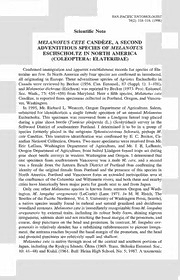
Melanotus cete Candeze, a second adventitious species of Melanotus Eschscholtz in North America (Coleoptera: Elateridae) PDF
Preview Melanotus cete Candeze, a second adventitious species of Melanotus Eschscholtz in North America (Coleoptera: Elateridae)
PAN-PACIFIC ENTOMOLOGIST 74(2): 118-119, (1998) Scientific Note MELANOTUS CETE CANDEZE, A SECOND ADVENTITIOUS SPECIES OF MELANOTUS ESCHSCHOLTZ IN NORTH AMERICA I (COLEOPTERA: ELATERIDAE) Confirmed immigration and apparent establishment records for species of Ela- teridae are few. In North America only four species are confirmed as introduced, all originating in Europe. Three adventitious species of Agriotes Eschscholtz in Canada were reviewed by Becker (1956. Can. Entomol., 87 (Suppl. 1): 1-101), and Melanotus dichrous (Erichson) was reported by Becker (1973. Proc. Entomol. Soc. Wash., 75: 454-458) from Maryland. Here a fifth species, Melanotus cete Candeze, is reported from specimens collected in Portland, Oregon, and Vancou¬ ver, Washington. In 1995, Mr. Richard L. Westcott, Oregon Department of Agriculture, Salem, submitted for identification a single female specimen of an unusual Melanotus Eschscholtz. This specimen was recovered from a Lindgren funnel trap placed during a pine shoot beetle (Tomicus piniperda (L.) (Scolytidae)) survey in the Sell wood District of southeastern Portland. I determined it to be in a group of species formerly placed in the subgenus Spheniscosomus Schwarz, perhaps M. cete Candeze. This tentative identification was confirmed by E. C. Becker, Ca¬ nadian National Collection, Ottawa. Two more specimens were received from Mr. Eric LaGasa, Washington Department of Agriculture, and Mr. J. R. LaBonte, Oregon Department of Agriculture, from baited Lindgren funnel traps set during pine shoot beetle surveys in western Washington and Oregon. I determined that one specimen from southwestern Vancouver was a male M. cete, and a second was a female from the Jantzen Beach District of Portland thus confirming the identity of the original female from Portland and the presence of this species in North America. Portland and Vancouver form an extended metropolitan area at the confluence of the Columbia and Willamette rivers, and both these and nearby cities have historically been major ports for goods sent to and from Japan. Only one other Melanotus species is known from western Oregon and Wash¬ ington, M. longulus oregonensis (LeConte) (Lane 1971. In M. H. Hatch, The Beetles of the Pacific Northwest, Vol. 5. University of Washington Press, Seattle), a native species usually found in ruderal and natural grassland and deciduous woodland ecotones. Melanotus cete is immediately recognizable from M. longulus oregonensis by external traits, including its robust body form, shining nigrous integument, antenna short and not reaching the basal margin of the pronotum, and coarse, deep punctures on the head and pronotum. In contrast, M. longulus ore¬ gonensis is relatively slender, has a subshining rufobrunneous to piceous integu¬ ment, the antenna reaches beyond the basal margin of the pronotum, and the head and pronotal punctures are relatively small and shallow. Melanotus cete is native through most of the central and southern portions of Japan, including the Ryukyu Islands. Ohira (1969. Trans. Shikoku Entomol. Soc., 10: 41-48) and Kishii (1961. Bull. Heian High School, No. 5; 1987. A taxonomic 1998 SCIENTIFIC NOTE 119 study of the Japanese Elateridae (Coleoptera), with the keys to the subfamilies, tribes and genera. Auth. Publ., Kyoto) provided the most recent morphological, distributional, and taxonomic information for this species in Spheniscosomus. Ac- A cording to Ohira [1962. Morphological and taxonomic study on the larvae of Elateridae in Japan (Coleoptera). Aichi Gakugei University, Okazaki City], the A larva of M. cete is edaphic. Ohira and Hakamura (1994. J. Hiba Soc. Nat. Hist., 160: 11-20) noted that this is a common species in and around mixed forests. This note is the first report of this species outside of its native range. The recovery of a male and two females over a four-year period and upwards of approximately 20 km apart suggests the possibility of a naturalizing population. Any agricultural pest status of this species remains unproven. However, because the larvae of most species of Melanotus are predatory (unpubl. rearing studies), though many are facultatively phytophagous on sprouting seeds and growing roots of graminoids, the agronomic role of this introduced species will probably be minima] if any. Inferences on its ecological impact in natural and seminatural habitats remain for examination as no studies have been conducted on interspecific competition or replacement in Elateridae. Material examined.—OREGON. MULTNOMAH Co.: Portland-Sellwood, 13 Jul 1993, PSB trap, Dan Hilbum, 1 female, deposited: Oregon Department of Agriculture; Portland, Jantzen Beach District, “Red Lion Inn”, 20 Jun 1997, J. R. LaBonte, ex Lindgren trap #51-08, a-pinene bait, 1 female; deposited: author’s collection. WASHINGTON. CLARK Co.: Vancouver, port area, 8-29 May 1996, Wash. Dept. Agric., 1 male; deposited: author’s collection. Acknowledgement.—Thanks to Ms. Tomoko Ota, Brookings, for assistance in translating Japanese documents, and to Mr. R. L. Westcott, Salem, and Dr. E. C. Becker, Agriculture Canada, Ottawa, for discussions and manuscript improve¬ ments. This is article #3034 of the South Dakota Agricultural Experiment Station. Paul J. Johnson, Insect Research Collection, Box 2207A, South Dakota State University, Brookings, South Dakota 57007, U.S.A. Received 4 Apr 1997; Accepted 30 Apr 1997.
